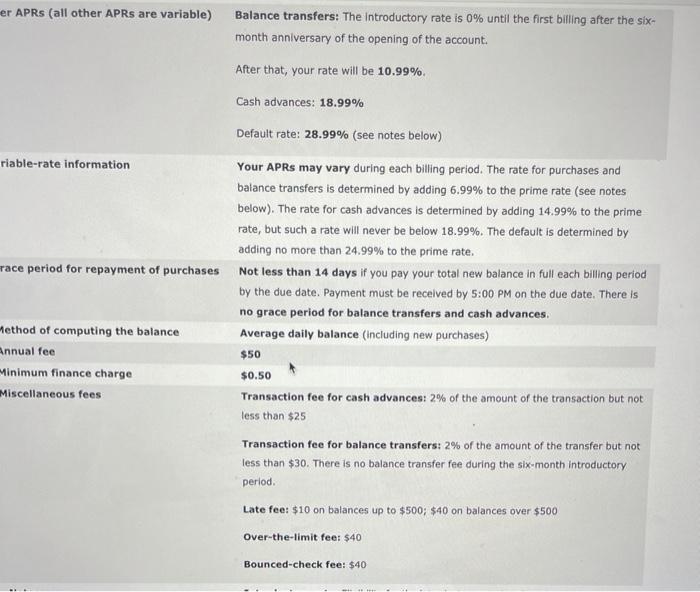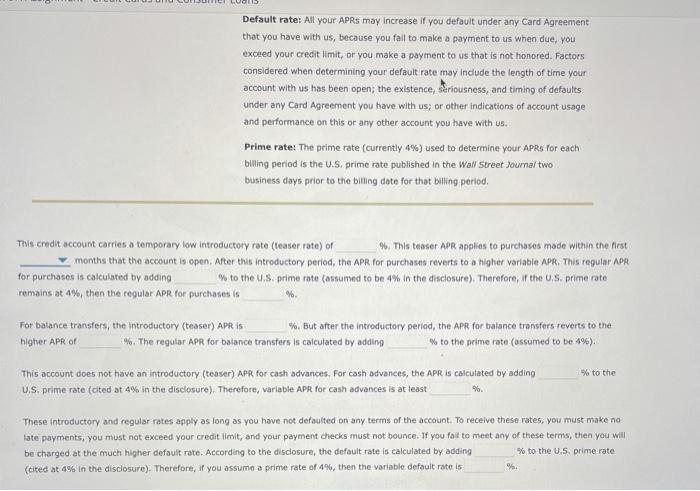07: Assignment - Credit Cards and Consumer Loans 3. Credit card rates - Introductory (teaser) rates, cash advancerates, and default rates Credit card companies regularly offer very low introductory rates (or teaser rates) to entice borrowers to apply for an account. Generally, the teaser APR (annual percentage rate) apples only during an introductory time period, after which the APR reverts to a much higher fixed or variable interest rate Higher rates are often charged for cash advances. Also, if you fail to live up to any of the terms of your credit card agreement, you may then be charged interest at a much higher default rate. For example, if you make a late payment, exceed your credit limit, or bounce a payment check, then the account may switch to the default rate Review the following sample credit card disclosure box. Then answer the questions that follow. Do not round your answer Interest Rates and Fees As required by law,rates, fees, and other costs of this credit card offer are disclosed here. All account terms are governed by the Credit Card Agreement sont with the card, Account terms are not guaranteed for any period of times all terms, including the Arts and fees, may change in accordance with the Agreement and applicable law Annual Percentage Rate (APR) for The Introductory rate (se noons below) 2.99% until the first billing after the se purchases month angiversary of opening the account After that, your rate will be 10.99%(variable rate) Other APR (all other APRs are variable) Balance transfers: The introductory rate is 0% until the first billing after the se month anniversary of the opening of the account. After that, your rate will be 10.99% Cash advances 18.09% Variable-rate information Oduit rate: 28.99% (se notes below) Your APRs may vary during each billing period. The rate for purchases and balance transfers is determined by adding 6.995 to the prime rate son notes below). The rate for cash advances is determined by adding 14.99% to the prime bowl.B.CDB-dating er APRs (all other APRs are variable) Balance transfers: The introductory rate is 0% until the first billing after the six- month anniversary of the opening of the account. After that, your rate will be 10.99% Cash advances: 18.99% Default rate: 28.99% (see notes below) riable-rate information Your APRs may vary during each billing period. The rate for purchases and balance transfers is determined by adding 6.99% to the prime rate (see notes below). The rate for cash advances is determined by adding 14.99% to the prime rate, but such a rate will never be below 18.99%. The default is determined by adding no more than 24.99% to the prime rate. race period for repayment of purchases Not less than 14 days if you pay your total new balance in full each billing period by the due date. Payment must be received by 5:00 PM on the due date. There is no grace period for balance transfers and cash advances. Method of computing the balance Average daily balance (including new purchases) Annual fee $50 Minimum finance charge Miscellaneous fees Transaction fee for cash advances: 2% of the amount of the transaction but not $0.50 less than $25 Transaction fee for balance transfers: 2% of the amount of the transfer but not less than $30. There is no balance transfer fee during the six-month Introductory period. Late fee: $10 on balances up to $500; $40 on balances over $500 Over-the-limit fee: $40 Bounced-check fee: $40 Default rate: All your APRs may increase if you default under any Card Agreement that you have with us, because you fail to make a payment to us when due, you exceed your credit limit, or you make a payment to us that is not honored. Factors considered when determining your default rate may include the length of time your account with us has been open; the existence, seriousness, and timing of defaults under any Card Agreement you have with us; or other indications of account usage and performance on this or any other account you have with us. Prime rate: The prime rate (currently 4%) used to determine your APRs for each billing period is the U.S. prime rate published in the Wall Street Jouma/ two business days prior to the biling date for thot billing period, This credit account carries a temporary low introductory rate (teaser rate) of %. This teaser APR applies to purchases made within the first months that the account is open, After this introductory period, the APR for purchases reverts to a higher variable APR. This regular APR for purchases is calculated by adding % to the U.S. prime rate (assumed to be 4% in the disclosure). Therefore, If the U.S. prime rate remains at 4%, then the regular APR for purchases is % For balance transfers, the introductory (teaser) APRIS %. But after the introductory period, the APR for balance transfers reverts to the higher APR of %. The regular APR for balance transfers is calculated by adding % to the prime rate (assumed to be 4%). This account does not have an introductory (teaser) APR for cash advances. For cash advances, the APR is calculated by adding U.S. prime rate (cited at 4% in the disclosure). Therefore, variable APR for cash advances is at least % to the These introductory and regular rates apply as long as you have not defaulted on any terms of the account. To receive these rates, you must make no late payments, you must not exceed your credit limit, and your payment checks must not bounce. If you fail to meet any of these terms, then you will be charged at the much higher default rate. According to the disclosure, the default rate is calculated by adding % to the U.S. prime rate (cited at 4% in the disclosure). Therefore, if you assume a prime rate of 4%, then the variable default rate is 9









